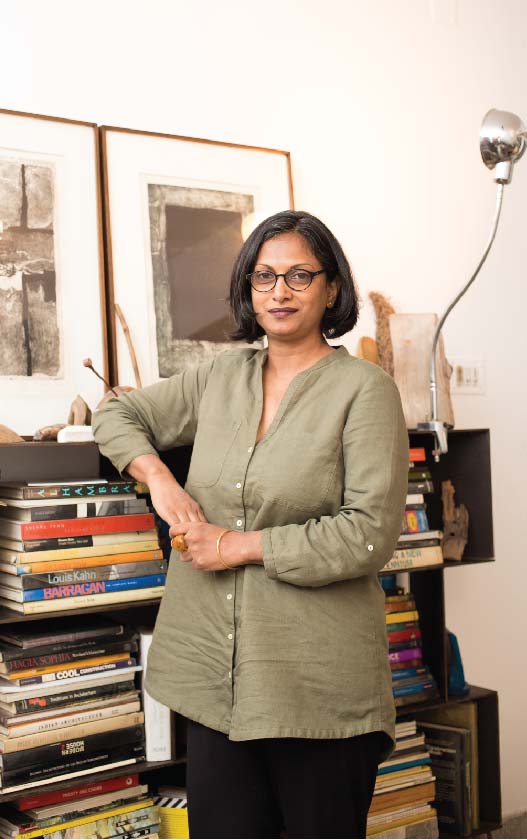Aidha Cader sits down with globally renowned Bangladeshi Architect Marina Tabassum and discusses her groundbreaking mosque project
Photographs of the mosque from MTA, Sandro Di Carlo Darsa and Hasan Saifuddin Chandan Marina Tabassum’s Portrait by Kazi Mukul

Located within the urban hub of Uttar, with its ever-changing skyline and unplanned development stands the Bait Ur Rouf Mosque. Built on a contemporary design using the cornerstone material of Bangladesh, the clay fired brick embodies local culture and resonates spiritual functionality. It was recently nominated for the 2016 Aga Khan Award for Architecture.
“I was commissioned by my grandmother who owned the land and wished it to be used as a neighbourhood mosque,” says Marina Tabassum. The project, which began in 2008, stumbled along many hurdles and the most challenging was to raise funds. For Marina it was a personal task and she shouldered the responsibility, not only as the architect and designer, but she also solicited the finances, clients and builders. The mosque was completed in 2013 and stands as a testament of Marina’s vision of artistic and architectural perfection. Working within limitations as in this case, the budget stretches ones intellect to think beyond the box and create something that is beautiful, functional, cost effective and low maintenance.
It’s important that people don’t see the small budget but the grandness of the space and light, which is vital for me as an architect,” she adds.
This being her first mosque project, Marina, who is also the Director Academic of Bengal Institute of Architecture, Landscape & Settlement, extensively researched on the subject from both local and international source materials. Her work in presenting the guidelines for the Abu Dhabi mosques gave her an in-depth understanding of the architecture and the functionality of a mosque space. Her personal preference was the Sultanate period mosques built in Bangladesh, which influenced her design element. The most striking feature is that it is void of any traditional symbolism attached to mosque architecture. There are no domes, minarets, moon and stars as decorative elements. This was a conscious decision by Marina to break free from our need to feel attached to the divine space with symbolisms.
“The quintessential of tradition is not in the ashes but in the fire,” Marina shares.
She further explains that the the ashes are mere symbols but the fire signifies spirituality. The Bait Ur Rouf Mosque is more than just a mosque for congregational prayers. Its layout is designed to create community centres to facilitate Islamic lectures, and other communal activities. With regard to a separate section for women Marina says, “Women attending the mosque in that locality were not prevalent, however, if and when the need arises, we can construct an upper floor so that they can have a full view and yet be separated.”
The base structure is at a thirteen-degree angle to the Ka’aba direction. The exterior structure is a square with a tubular shape inserted into the interior. This creates a rotation of the prayer hall, forming light courts on the four sides. The congregational hall is raised on eight columns. Auxiliary functions are located in spaces created by the outer square and the cylinder. A key element is the play of light and shadow. The glass openings on the ceiling breathe in natural light, thereby creating an artistic perfection and cost effective lighting. Also, the architectural torrents enhance the airflow, which provides an environmentally sustainable ventilation system. “We have designed the walls as breathing walls with perforated and pours bricks,” says Marina. The Mihrab is highlighted as a shaft of natural light and enhances the interior space. The interior, much like the exterior, void of any form of ornamentation and artistic precision, is achieved by the effective use of light shaft set across the backdrop of clay bricks.
“The nomination for the Aga Khan Award is a very prestigious platform,” confirms Marina. Unlike other awards the nominee is recommended by a third party and the project is evaluated by an independent review board representing the Aga Khan Foundation. On site evaluation, video, photographs, analysis of many criteria including its social and environmental contexts are thoroughly scrutinised before the review board. This is Marina’s second nomination the first being the Architect’s house, a joint project with with Kashef Chowdhury in 2005 as part of URBANA.
“I don’t have a signature style. I believe every project requires a different element mind-set and design,” says Marina. Being a woman in this industry was personally never a challenge for her. She feels that though over 50% of girls are entering the field of architecture, only a nominal few are committed to strive further. “If my work and such nominations can encourage the next generation of young women architects to hold firm in the practice of the profession, I would feel accomplished,” smiles Marina. To be an inspiration for the next generation is as important as the structural monuments that stand the test of time, a core value for Marina Tabassum.
.



